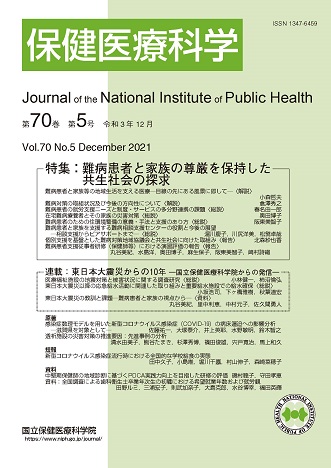Volume 70, Issue 5
The pursuit of an inclusive society guaranteeing the dignity of intractable disease clients and their families
Displaying 1-17 of 17 articles from this issue
- |<
- <
- 1
- >
- >|
Topics
-
Article type: Preface
2021 Volume 70 Issue 5 Pages 459
Published: December 28, 2021
Released on J-STAGE: February 09, 2022
Download PDF (1310K) -
Article type: Note
2021 Volume 70 Issue 5 Pages 460-468
Published: December 28, 2021
Released on J-STAGE: February 09, 2022
Download PDF (3353K) -
Article type: Note
2021 Volume 70 Issue 5 Pages 469-476
Published: December 28, 2021
Released on J-STAGE: February 09, 2022
Download PDF (2306K) -
Article type: Review
2021 Volume 70 Issue 5 Pages 477-487
Published: December 28, 2021
Released on J-STAGE: February 09, 2022
Download PDF (2694K) -
Article type: Review
2021 Volume 70 Issue 5 Pages 488-494
Published: December 28, 2021
Released on J-STAGE: February 09, 2022
Download PDF (1505K) -
Article type: Review
2021 Volume 70 Issue 5 Pages 495-501
Published: December 28, 2021
Released on J-STAGE: February 09, 2022
Download PDF (1592K) -
Article type: Review
2021 Volume 70 Issue 5 Pages 502-513
Published: December 28, 2021
Released on J-STAGE: February 09, 2022
Download PDF (3133K) -
Article type: Practice Report
2021 Volume 70 Issue 5 Pages 514-521
Published: December 28, 2021
Released on J-STAGE: February 09, 2022
Download PDF (2515K) -
Article type: Practice Report
2021 Volume 70 Issue 5 Pages 522-531
Published: December 28, 2021
Released on J-STAGE: February 09, 2022
Download PDF (1736K)
Series 10 years since the Great East Japan Earthquake: National Insitutte of Public Health
-
Article type: Review
2021 Volume 70 Issue 5 Pages 532-537
Published: December 28, 2021
Released on J-STAGE: February 09, 2022
Download PDF (1409K) -
Article type: Review
2021 Volume 70 Issue 5 Pages 538-548
Published: December 28, 2021
Released on J-STAGE: February 09, 2022
Download PDF (1839K) -
Article type: Research Data
2021 Volume 70 Issue 5 Pages 549-556
Published: December 28, 2021
Released on J-STAGE: February 09, 2022
Download PDF (1778K)
Articles
-
Article type: Original
2021 Volume 70 Issue 5 Pages 557-568
Published: December 28, 2021
Released on J-STAGE: February 09, 2022
Download PDF (3197K) -
Article type: Original
2021 Volume 70 Issue 5 Pages 569-578
Published: December 28, 2021
Released on J-STAGE: February 09, 2022
Download PDF (1650K) -
Article type: Brief Report
2021 Volume 70 Issue 5 Pages 579-586
Published: December 28, 2021
Released on J-STAGE: February 09, 2022
Download PDF (1431K) -
Article type: Research Data
2021 Volume 70 Issue 5 Pages 587-597
Published: December 28, 2021
Released on J-STAGE: February 09, 2022
Download PDF (1608K) -
Article type: Research Data
2021 Volume 70 Issue 5 Pages 598-606
Published: December 28, 2021
Released on J-STAGE: February 09, 2022
Download PDF (1526K)
- |<
- <
- 1
- >
- >|
